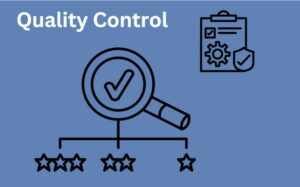Quality in business has always been a concept that is difficult to understand within companies. Whether in manufacturing or services, managers tend to misjudge the quality of their processes.
This is all the more true in small and medium-sized enterprises (SMEs), as well as in service companies. This is due to fewer resources and knowledge compared to larger companies.
What is Quality in Business?
With the advent of Industry 4.0 and the rise of automation, it becomes crucial to fully understand quality in order to measure and control it. This article, therefore, aims to quickly and concisely define quality in order to properly measure and control it.
Quality in business consists of producing a good or service that conforms the first time, in the right quantity, and at the right time.
A compliant product is a product that does not meet, neither more (excess quality) nor less (non-quality), the customer’s requirements.
Right the first time
Definition and manufacturing example
What do we mean by “right first time”? Quite simply that there has been no rework or repair in all stages of the manufacturing or service process.
One of the most common mistakes made by SMB managers is not recording a nonconformity because the product is not “majorly broken” or declared a total loss.
For example, a company manufactures house doors. At the assembly station, a door handle is installed and the lock does not work. The assembler removes the handle, then puts on another one. The company does not consider non-conformity, since the door will still be sold compliant to the customer. However, the door was not produced correctly the first time. This results in wasted production time.
In addition, during repairs, the employee does not produce other doors. This results in a loss of opportunity. Considering that a door produced is a door sold, if the employee manufactures 2 doors per hour and a door is worth $150, he is manufacturing for $300 per hour for the company. If he loses 15 minutes for a repair, we can estimate an opportunity cost loss of (15/60 * 200) = $75. Add to that the assembler’s salary.
Service Company Example
Another example, this time in the field of health, would be a patient for whom a treatment is prescribed that is not necessary. Let’s take patient X who has back pain. The doctor prescribes anti-inflammatories and Patient X’s problems persist.
Then, his doctor refers him to a chiropractor who will provide him with treatments to solve Patient X’s problem. We must therefore consider the first service, the prescription of an anti-inflammatory, as non-compliance since it was not necessary for this patient.
Quality in Business and Added value
In quality, the notion of “added value” is important. In the previous example, the anti-inflammatory prescription has no value for the client (patient X). Any company has an advantage in maximizing its value-added operations.
Overquality
With this in mind, we aim to give customers what they want the first time. In addition, you have to satisfy the customer only for what he asks for and not do more or less. Of course, if we do less, we will not be able to consider its quality, since we do not meet customer requirements.
However, too much is not enough. When we over-qualify, we pay more to manufacture a product or provide a service, when it is not necessary. This will affect our margins if we assume the additional costs or our selling price. Therefore, the customer does not only pay for what he needs.
Again, let’s take the example of the door manufacturing plant. A client requests a cherry door with a door handle that resists corrosion. According to these requirements, the company could manufacture a door with a handle in galvanized steel, stainless steel, or even a gold handle.
To meet customer requirements in a minimal way, it would be best to choose a galvanized steel handle. This meets his criteria, without having to spend a fortune to obtain the same result. The example may be exaggerated, but illustrates the concept of overquality well.
Finally, the principle of overquality also applies in the field of health. We want to provide the minimum care that allows patients to recover optimally. We often tend to want to do too much, which results in a waste of time and money. In a context where resources are scarce, it is essential to identify the needs of patients. We must target what is essential to them only.
Produce the Right Quantity at the Right Time
Quantity and Moment in Quality
Why bother to include the aspects of quantity and time in the definition of quality? Because if we trust the best companies and the “Lean” production principle, we increase the quality of our products when we adopt good work habits.
In our opinion, it is essential for a company to think in a systematic way. That is, to think in a system rather than in individual tasks or operations. By adding the notions of quantity and moment to quality, we aim to integrate this way of thinking.
Quantity (Overproduction)
In addition, overproduction is a waste that leads to product manipulations. When you produce just-in-time, you reduce inventory, and handling (risk of breakage and loss of time), and eliminate the risk of obsolete products.
Moment
When we produce at the right time, we avoid having to store and move the same order several times. We also reduce the risk of breakage, loss, or change (modification or cancellation).
Finally, we accelerate the moment when we take out money to produce a good or a service and when we get paid by our customers (cash conversion cycle).
Quality Control
Quality control (QC) is a process used to ensure that a product or service meets the required quality standards. It involves a series of inspections, tests, and measurements that are performed on the product or service to check for defects or errors.
The aim of quality control is to identify and correct any issues before the product or service is released to the market or delivered to the customer.
Quality control can be implemented at different stages of the production process, such as raw material inspection, in-process inspection, and final inspection.
In addition to inspections and tests, quality control may also involve process controls, statistical process control (SPC), and quality assurance (QA) activities.
The ultimate goal of quality control is to achieve customer satisfaction by providing products or services that meet or exceed their expectations in terms of quality, reliability, and performance.
How to Optimize Quality Control with Sampling Plans
Sampling plans are an effective way to optimize quality control by allowing organizations to inspect a representative sample of a product or process rather than examining every single item.
They can save time and money, while still ensuring that the product or process meets the required quality standards.
For more information about Sampling plans, here is an interesting article that covers pretty much all this topic!
Sampling Plans and Batch Control : Complete Guide – 100%!
Conclusion
In conclusion, quality control plays a vital role in the success of any business. By implementing effective quality control measures, businesses can ensure that their products or services meet customers’ expectations, resulting in increased customer satisfaction, loyalty, and positive word-of-mouth marketing.
Sampling plans are one such measure that can help optimize quality control by providing a systematic approach to selecting and testing samples, which can save time and resources while still ensuring the quality of the entire batch or production run.
In addition to quality control, businesses must also strive to achieve the concept of “right quantity, right time, and good the first time.”
This means producing the correct amount of products at the right time, without the need for rework or corrections due to quality issues.
By focusing on these three elements, businesses can improve their efficiency, reduce waste and costs, and ultimately deliver high-quality products that meet customer needs and expectations.










